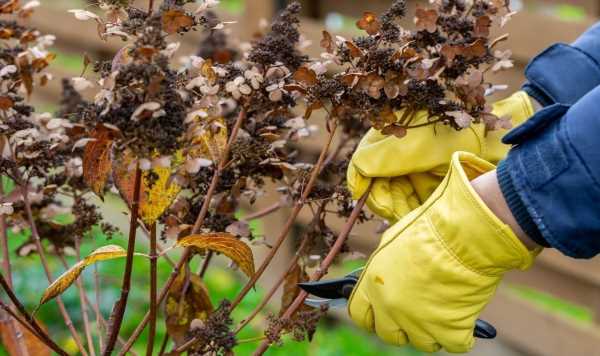Monty Don shares tips for pruning fruit trees
We use your sign-up to provide content in ways you’ve consented to and to improve our understanding of you. This may include adverts from us and 3rd parties based on our understanding. You can unsubscribe at any time. More info
During winter, most woody plants are dormant, as are the many diseases and insects that can potentially invade pruning cuts. Therefore, pruning when the weather is cold prevents your freshly pruned garden plants from getting infected. Winter pruning is also good for your plants, as it will leave them with extra root and energy reserves to quickly heal wounds and support vigorous spring growth that will obscure the pruning cuts.
Speaking exclusively to Express.co.uk, Holly Jones, sales and marketing manager at Garden Street, has shared a few “golden rules” for pruning plants.
She said: “It is best to prune plants during dormancy and after flowering. However, the time of the year will depend on what you are pruning. The best thing to do is research the plant you are pruning so you are sure you are pruning at the right time.”
Holly noted that gardeners should prune back to or just above a growing point rather than pruning too far back and just leaving a stem and completely removing any dead or diseased branches. Although she highlighted the importance of pruning the right amount. The expert warned: “Don’t over prune as this can result in permanent damage.”
Before gardeners begin pruning they should however make sure their tools are sharp as this will “reduce the risk of disease” due to the cut healing quicker.

So which plants should be pruned right now? Gardening experts at BackyardBoss have shared several common plants to “always” prune during winter.
1. Common abelia
This small evergreen shrub is part of the honeysuckle family and should be pruned in winter. These plants bloom from late spring through autumn, so pruning them in winter “helps retain their shape and controls their growth”.
The experts advised using hand pruners to thin up to a third of old stems to “promote new growth and prevent legginess”. They added: “Don’t shear abelia, as you risk cutting away new growth, leaving behind less healthy plant parts that’ll negatively affect your plant’s health.”
2. Panicle hydrangea
These types of hydrangeas are winter-hardy plants that bloom “stunning pyramidal panicles of creamy white or rosy pink flowers”. They prefer full sun, partial shade, and moist, well-draining soils to thrive.
DON’T MISS
‘Ideal temperature’ to avoid condensation, damp and mould in your home [EXPERT]
Remove ‘extremely stubborn’ stains from oven glass with ‘cheap’ staple [TIPS]
‘Great methods’ to remove ‘tough’ yellow stains from pillows [COMMENT]
The gardening pros advise to prune the stems just above “the fat bud (called a heading cut) to boost health and encourage the plant to produce larger flowers”.
3. Ninebark
These plants are known to produce a beautiful display in spring and summer when it boasts small pink or white flowers in spirea-like clusters. The plant prefers full sun, partial shade, and slightly-acidic loamy soils to thrive.
While this shrub is low-maintenance, gardeners can cut it to the ground to “boost its health” and “promote new growth”.
4. Sweet pepperbush
Part of the Clethraceae family, the sweet pepperbush can grow up to 10 feet in ideal conditions. The shrub produces spicy-sweet fragrant flowers in narrow, upright panicles and tolerates different soil types.

Although it’s a low-maintenance shrub like ninebark, gardeners are still advised to prune a third of old stems to the ground to “promote new growth, prevent legginess, and manage its size”.
The experts instructed: “Cut dead, damaged, and diseased branches to prevent the spread of diseases. If you’re unsure whether the branch is alive or dead, clip the top, and if it’s white, it’s alive.”
5. Crape myrtle
Boasting deep emerald foliage and paper-thin pink, white or lavender blooms, the crepe myrtle is no stranger to heights. If gardeners don’t prune them, they shouldn’t be surprised to see it cross 20 feet in height at maturity.
Nearly leafless in winter, this plant is “easy to prune”, according to the pros. Pruning them will make room for fresh growth.

6. Cape plumbago
These colourful flowers can be grown as annuals if gardeners plant them outdoors or perennials if they choose to grow them in containers that can be brought indoors during the cold winter months.
Whether this plant is growing in the ground or in containers, hard prune it in winter to control its growth, avoid legginess, and prevent it from growing too large.
7. Butterfly bush
Native to Asia, the butterfly bush is a drought-tolerant shrub that thrives in full sun and moist, well-drained soils. In the spring and summer, the butterfly bush turns heads with its fragrant cone-shaped panicles that come in many colours, including lilac, white, and pink.
For the “best flower appearance”, the gardening gurus advised “aggressively” pruning this plants (nearly to the ground) in late winter.
Source: Read Full Article
